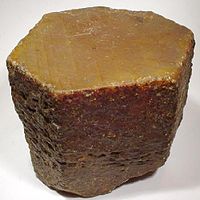Zoutpansberg
This article is largely based on an article in the out-of-copyright Encyclopædia Britannica Eleventh Edition, which was produced in 1911. (October 2014) |

Zoutpansberg was the north-eastern division of the
Voortrekkers
This was the district to which
South African Republic
It was not until 1864 that Zoutpansberg was definitively incorporated in the South African Republic as a result of the Transvaal Civil War.[2] The white settlers in Zoutpansberg had for many years a reputation for lawlessness, and were later regarded as typical "back velt Boers".
Native population
Zoutpansberg contained a larger native population than any other region of the Transvaal.[2] It was estimated at 201,539 in 1903.[1]
Minerals

Tregardt and his companions had been shown gold workings by the natives, and it was in this district in 1867–70, and in the neighbouring region of Lydenburg, that gold mines were first worked by Europeans south of the Limpopo. It is a highly mineralized area; next to gold, copper, found near the Limpopo River (where the Messina mine is located) is also extracted here.
See also
- Dzata ruins
- Kingdom of Mapungubwe
- Schoemansdal, Limpopo, abandoned Voortrekker town
References
- ^ a b Wheelwright, C. A. (2 January 1904) Native Affairs, Transvaal Administration Reports for 1903. B.18. Annexure "A": Native Commissioners' Annual Reports, Northern Division
- ^ a b c One or more of the preceding sentences incorporates text from a publication now in the public domain: Chisholm, Hugh, ed. (1911). "Zoutpansberg". Encyclopædia Britannica. Vol. 28 (11th ed.). Cambridge University Press. p. 1045.
- ^ van Zyl, Anton (18 December 2015). "2. The senator who preferred 'velskoene'". zoutnet.co.za. Retrieved 6 August 2018.
